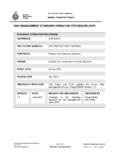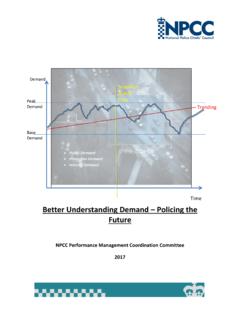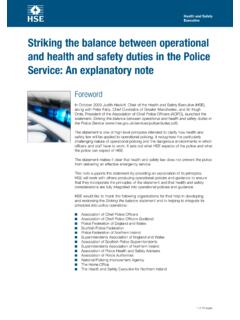Transcription of RESEARCH REPORT 251 - Health and Safety Executive
1 HSE Health & Safety Executive Structural deterioration of tractor Safety cabs with age Prepared by Silsoe RESEARCH Institute for the Health and Safety Executive 2004 RESEARCH REPORT 251 HSE Health & Safety Executive Structural deterioration of tractor Safety cabs with age A J Scarlett BSc PhD MIAgrE A D Stockton HTC J S Price HND AMIAgrE J M Bacon BEng Silsoe RESEARCH Institute Wrest Park Silsoe Bedford MK45 4HS An investigation was undertaken to determine the prevalence, structural severity and practical implications of tractor Safety cab / roll-over protective structure (ROPS) structural deterioration with age within the UK. A detailed survey of levels of cab deterioration present upon approximately 400 used tractors , manufactured in the period 1970-1990, was conducted at major UK vehicle auctions. The cabs of seven example used tractors , exhibiting representative levels of deterioration, were partially dismantled to enable detailed visual inspection of deterioration / corrosion present.
2 Five of these vehicles were subsequently subjected to a recognised Safety cab / ROPS structural testing procedure, to determine if the structures were capable of providing adequate roll-over protection. Given comparable operating environments and in-service care, initial susceptibility to deterioration (corrosion), subsequent rate of deterioration development, and ability to continue to provide effective roll-over protection despite deterioration, were found to be extremely dependent upon Safety cab / ROPS design and method of construction. Trends encountered in, and potential reasons for, the levels of cab deterioration found are discussed, together with the practical implications for vehicle users, manufacturers and enforcement agencies. This REPORT and the work it describes were funded by the Health and Safety Executive (HSE).
3 Its contents, including any opinions and/or conclusions expressed, are those of the authors alone and do not necessarily reflect HSE policy. HSE BOOKS Crown copyright 2004 First published 2004 ISBN 0 7176 2873 6 All rights reserved. No part of this publication may be reproduced, stored in a retrieval system, or transmitted in any form or by any means (electronic, mechanical, photocopying, recording or otherwise) without the prior written permission of the copyright owner. Applications for reproduction should be made in writing to: Licensing Division, Her Majesty's Stationery Office, St Clements House, 2-16 Colegate, Norwich NR3 1BQ or by e-mail to ii ACKNOWLEDGEMENTS Silsoe RESEARCH Institute gratefully acknowledges the assistance provided by Cheffins Auctioneers, Cambridge; CNH (UK) Ltd and the DLG Tractor Testing Station, Gross-Umstadt, Germany, during the course of this investigation.
4 Iii iv CONTENTS Page No. Acknowledgements iii Contents v Executive Summary vii 1. INTRODUCTION 1 2. ASSESSMENT OF PROBLEM 5 Methodology 5 Results 6 3. TEST TRACTOR SELECTION AND PROCUREMENT 11 4. TRACTOR CAB INSPECTION AND STRUCTURAL TESTING 15 Ford 5000 16 Visual inspection 16 Structural test 18 Summary 20 Massey Ferguson 690 22 Visual inspection 22 Structural test 24 Summary 26 John Deere 2040S XE 28 Visual inspection 28 John Deere 2140 31 Visual inspection 31 Structural test 33 Summary 34 Ford 4610 AP 36 Visual inspection 36 Structural test 39 Summary 43 Massey Ferguson 3080 44 Visual inspection 44 Summary 47 Case-IH 956 XL 48 Visual inspection 48 v Structural test 51 Summary 53 5.
5 DISCUSSION 57 Extent of the Perceived Problem 57 Deteriorated Cab Inspection & Testing 58 Current and Future Implications 59 6. CONCLUSIONS & RECOMMENDATIONS 63 7. REFERENCES 67 APPENDICES 69 Appendix 1 Preliminary Survey of Tractor Safety Cab Deterioration 69 Appendix 2 Tractor Cab Condition Evaluation Form 75 Appendix 3 Tractor Cab Condition Survey Data 76 vi Executive SUMMARY The objectives of this investigation were to determine the prevalence, structural severity and practical implications of tractor Safety cab / roll-over protective structure (ROPS) structural deterioration with age within the UK. A detailed survey of levels of cab deterioration present upon approximately 400 used tractors , manufactured in the period 1970-1990, was conducted at major UK vehicle auctions. Following purchase at auction, the cabs of seven example tractors , exhibiting representative levels of deterioration, were partially dismantled to enable detailed visual inspection of deterioration / corrosion present.
6 Five of these vehicles were subsequently subjected to a recognised (OECD Code 4) Safety cab / ROPS structural testing procedure, to determine if the structures were still capable of providing adequate roll-over protection. Given comparable operating environments and in-service care, initial susceptibility to deterioration (corrosion), subsequent rate of deterioration development, and ability to continue to provide effective roll-over protection despite deterioration, were found to be extremely dependent upon Safety cab / ROPS design and method of construction. 13% of the tractors surveyed exhibited sufficient levels of deterioration (corrosion) upon Safety cab / ROPS structural members to be graded in poor condition and cause their ability to protect the operator during a roll-over incident to be questioned.
7 The deterioration level of non structural cab components (mudguards / fenders) was found to increase with vehicle age, the sheet metalwork of older tractors being (predictably) in poorer condition. However, the deterioration of cab structural components (cab vertical members & mountings to the tractor chassis) did not follow this trend, indicating that factors in addition to cab age influence rate of deterioration. Structural deterioration was found to be most prevalent upon tractors manufactured in the 1981-1985 period, followed by those built in 1976-1980. tractors manufactured before this time (1970-1975) and fitted with cabs or ROPS of more simplistic construction, remained in better condition, as did the cabs of post-1985 vehicles. Advances in cab design and manufacturing techniques over the 1970-1985 period resulted in a transition from simplistic, thick-walled structural members, supplemented by non-structural sheet metalwork, to designs where role demarcation between thick-walled structural members and thin-wall non-structural members became less distinct, the latter being required to make a contribution to overall cab strength / energy absorption.
8 The latter designs are more sensitive to corrosion-related deterioration, particularly if embodying dirt / water traps and/or ineffective cab sealing, structural member internal drainage and anti-corrosion treatments. Such advanced cab designs entered the UK market during the late 1970 s early 1980 s, and have proved (with certain exceptions) to be susceptible to structural deterioration. Even if exhibiting significant levels of structural deterioration, tractor Safety cabs / ROPS may still perform adequately, in terms of structural strength and energy absorption capability, as determined by recognised (new cab) testing procedures (4 of the 5 example deteriorated cabs passed the structural re-test). However, in many instances the degree of deterioration and/or the failure mode during testing compromised cab integrity to the extent that the structure may not have prevented driver ejection and injury during a roll-over event, unless a seat restraint (belt) had been worn.
9 Whilst not necessarily equating to inadequate operator protection in the event of an overturn, such ROPS behaviour will greatly increase this risk. Additionally, instances of missing cab mounting bolts, incorrect re-installation (following removal for major servicing of the vehicle) or substitution of inferior quality examples, were found to be common. The vital role played by these components in the overall performance of any ROPS, new or old, and the consequent need for regular checking, may not be adequately appreciated. vii Current cab design and construction reflects a desire for cost effectiveness and ease of manufacture, frequently resulting in clean, minimalist designs incorporating rolled tubular steel structural members of greater wall thickness. Given the absence of dirt / water traps & water ingress, and adequate anti-corrosion treatment(s), such designs will probably be less susceptible to age-related deterioration, but in reality only the passage of time will tell.
10 Increased annual utilisation of modern tractors during the last 15 years means that, unless fitted with a cab of flawed design, it is likely that mechanical component failure will limit vehicle service life before cab deterioration reaches undesirable levels. Where possible, low intensity users of older, cheaper tractors are likely to select used vehicles of good cosmetic appearance, if only to maximise the useful working life and minimise the need for relatively expensive cosmetic maintenance. Additionally, the current UK demand for used replacement components for older (~ pre-1985) tractors , maintains a market requirement for tractors (frequently fitted with deteriorated cabs) to be broken for spares. By these means the problem of tractor cab deterioration in the UK is probably self-policing to a large extent.















